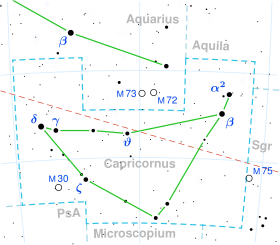Phi Capricorni
| Observation data Epoch J2000.0 Equinox J2000.0 (ICRS) | |
|---|---|
| Constellation | Capricornus |
| Right ascension | 21h 15m 37.89982s[1] |
| Declination | −20° 39′ 06.1032″[1] |
| Apparent magnitude (V) | +5.16[2] |
| Characteristics | |
| Spectral type | K0 II-III[3] |
| B−V color index | +1.15[2] |
| Astrometry | |
| Radial velocity (Rv) | −4.5±0.5[4] km/s |
| Proper motion (μ) | RA: +15.01[1] mas/yr Dec.: −2.07[1] mas/yr |
| Parallax (π) | 5.07 ± 0.25 mas[1] |
| Distance | 640 ± 30 ly (197 ± 10 pc) |
| Absolute magnitude (MV) | −1.16±0.107[5] |
| Details | |
| Mass | 2.63[6] M☉ |
| Luminosity | 447[6] L☉ |
| Surface gravity (log g) | 1.77[5] cgs |
| Temperature | 4,490±25[6] K |
| Metallicity [Fe/H] | −0.15[5] dex |
| Rotational velocity (v sin i) | 3.8[7] km/s |
| Age | 1.24[6] Gyr |
| Other designations | |
| Database references | |
| SIMBAD | data |
Phi Capricorni (φ Cap, φ Capricorni) is a solitary[9] star in the southern constellation of Capricornus. It is visible to the naked eye with an apparent visual magnitude of +5.16.[2] Based upon an annual parallax shift of 5.07 mas as seen from the Earth,[1] the star is located about 640 light years from the Sun, give or take 30 light years.
This is an evolved, orange-hued K-type giant/bright giant star with a stellar classification of K0 II-III[3] It shows an infrared excess, which may be due to leftover material from a mass-loss event.[7] The star has an estimated 2.63 times the mass of the Sun,[6] and radiates 447 times the solar luminosity from its photosphere at an effective temperature of 4,490 K.[6] Phi Capricorni is around 1.24[6] billion years old and is spinning with a projected rotational velocity of 3.8 km/s.[7]
Chinese Name[edit]
In Chinese, 十二國 (Shíer Guó), meaning Twelve States, refers to an asterism which is represent twelve ancient states in the Spring and Autumn period and the Warring States period, consisting of φ Capricorni, ι Capricorni, 38 Capricorni, 35 Capricorni, 36 Capricorni, χ Capricorni, θ Capricorni, 30 Capricorni, 33 Capricorni, ζ Capricorni, 19 Capricorni, 26 Capricorni, 27 Capricorni, 20 Capricorni, η Capricorni and 21 Capricorni.[10] Consequently, the Chinese name for φ Capricorni itself represents the state Chu (楚),[11] together with ε Ophiuchi in Right Wall of Heavenly Market Enclosure (asterism).[12][13]
R. H. Allen had opinion that φ Capricorni, together with χ Capricorni, represented the state Wei (魏).[13]
References[edit]
- ^ a b c d e f van Leeuwen, F. (2007), "Validation of the new Hipparcos reduction", Astronomy and Astrophysics, 474 (2): 653–664, arXiv:0708.1752, Bibcode:2007A&A...474..653V, doi:10.1051/0004-6361:20078357, S2CID 18759600.
- ^ a b c Corben, P. M.; Stoy, R. H. (1968), "Photoelectric Magnitudes and Colours for Bright Southern Stars", Monthly Notes of the Astronomical Society of Southern Africa, 27: 11, Bibcode:1968MNSSA..27...11C.
- ^ a b Houk, N.; Smith-Moore, M. (1988), Michigan Catalogue of Two-dimensional Spectral Types for the HD Stars, vol. 4, Bibcode:1988mcts.book.....H.
- ^ Gontcharov, G. A. (November 2006), "Pulkovo Compilation of Radial Velocities for 35495 Hipparcos stars in a common system", Astronomy Letters, 32 (11): 759–771, arXiv:1606.08053, Bibcode:2006AstL...32..759G, doi:10.1134/S1063773706110065, S2CID 119231169.
- ^ a b c Park, Sunkyung; et al. (2013), "Wilson-Bappu Effect: Extended to Surface Gravity", The Astronomical Journal, 146 (4): 73, arXiv:1307.0592, Bibcode:2013AJ....146...73P, doi:10.1088/0004-6256/146/4/73, S2CID 119187733.
- ^ a b c d e f g Luck, R. Earle (2015), "Abundances in the Local Region. I. G and K Giants", Astronomical Journal, 150 (3), 88, arXiv:1507.01466, Bibcode:2015AJ....150...88L, doi:10.1088/0004-6256/150/3/88, S2CID 118505114.
- ^ a b c Fekel, Francis C.; Watson, Lyndon C. (November 1998), "A Search for Lithium-Rich Giants among Stars with Infrared Excesses", The Astronomical Journal, 116 (5): 2466–2474, Bibcode:1998AJ....116.2466F, doi:10.1086/300614.
- ^ "phi Cap", SIMBAD, Centre de données astronomiques de Strasbourg, retrieved 2017-05-10.
- ^ Eggleton, P. P.; Tokovinin, A. A. (September 2008), "A catalogue of multiplicity among bright stellar systems", Monthly Notices of the Royal Astronomical Society, 389 (2): 869–879, arXiv:0806.2878, Bibcode:2008MNRAS.389..869E, doi:10.1111/j.1365-2966.2008.13596.x, S2CID 14878976.
- ^ (in Chinese) 中國星座神話, written by 陳久金. Published by 台灣書房出版有限公司, 2005, ISBN 978-986-7332-25-7.
- ^ (in Chinese) AEEA (Activities of Exhibition and Education in Astronomy) 天文教育資訊網 2006 年 7 月 4 日
- ^ (in Chinese) AEEA (Activities of Exhibition and Education in Astronomy) 天文教育資訊網 2006 年 6 月 24 日
- ^ a b Allen, Richard Hinckley (1963), "Capricornus", Star Names, Their Lore and Meaning, Dover, retrieved 2017-05-09.

